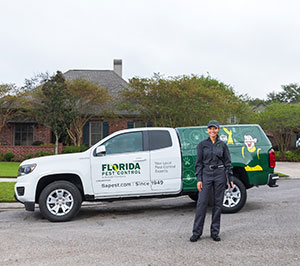A1 Bed Bug Exterminator Charlotte - Efficient and Affordable Services
A1 Bed Bug Exterminator Charlotte - Efficient and Affordable Services
Blog Article
Bed Insect Treatment Malfunction: Comparing Chemical Vs. Non-Chemical Solutions
In the realm of bug control, specifically when dealing with the relentless concern of bed pests, the choice in between chemical and non-chemical treatment options can be a crucial one. Both strategies supply distinct benefits and drawbacks, influencing variables such as performance, safety and security considerations, and overall expense. By analyzing the nuanced information of each approach, a more clear understanding of which path to go after in addressing a bed bug problem can be attained.
Effectiveness of Chemical Treatments
Chemical treatments for bed pest infestations have been widely identified for their quick and powerful effectiveness in removing these parasites. When taking into consideration the performance of chemical therapies, it is crucial to understand that they can provide a complete and fast solution to a bed insect issue.
Moreover, chemical treatments have the advantage of providing recurring results, indicating that they can remain to remove bed bugs even after the preliminary application. This residual action is particularly valuable in combating any potential re-infestations. Additionally, the quick activity of chemical therapies can bring relief to individuals encountering severe bed bug invasions, enabling them to regain control of their space swiftly.
Security Problems With Chemical Solutions
When using chemical solutions for bed bug therapy is ensuring the safety of owners and the setting,One crucial aspect that needs mindful factor to consider. While chemical treatments can be effective in eliminating bed pests, they might posture risks otherwise managed appropriately. One of the main safety and security interest in chemical remedies is the possible harm they can trigger to human health and wellness. Exposure to specific chemicals made use of in bed bug therapies can result in breathing issues, skin inflammation, or various other negative reactions, especially in individuals with pre-existing problems or sensitivities. Additionally, incorrect application or dose of chemical pesticides can cause toxic deposits remaining in the treated location, positioning lasting health and wellness dangers to passengers.
Additionally, the ecological impact of chemical services is an additional considerable consideration. Some pesticides made use of in bed bug treatments might be unsafe to helpful pests, wildlife, and environments if they leach into the soil or water systems. It is vital to use chemical therapies judiciously, following safety and security standards, and considering less harmful alternatives to reduce these dangers and make sure the reliable and risk-free management of bed pest infestations.
Benefits of Non-Chemical Approaches
Taking into consideration the prospective security issues and ecological influence connected with chemical solutions for bed pest treatment, checking out non-chemical approaches provides an appealing option with a number of distinctive benefits. Non-chemical treatments are ecologically pleasant, as they do not add to air or water pollution, making them a lasting option for pest control.
Additionally, non-chemical remedies can be effective in targeting bed insects, including hard-to-reach locations where chemical therapies may not permeate. Techniques such as heat therapy, vacuuming, heavy steam cleaning, and mattress encasements give thorough obliteration without using damaging chemicals. Additionally, non-chemical approaches can be less disruptive, calling for minimal preparation and permitting for quicker reentry right into dealt with areas. Generally, going with non-chemical bed insect therapy approaches not only prioritizes security and ecological protection but likewise makes certain effective and detailed bug control.
Limitations of Non-Chemical Treatments

Furthermore, non-chemical therapies frequently require multiple applications to attain effective obliteration. This can be taxing and might not always guarantee complete elimination of all bed bugs and their eggs, especially in hard-to-reach or covert places.
Additionally, the success of non-chemical therapies greatly counts on correct application and thoroughness, which can be challenging termite extermination cost for individuals without expert competence. Inadequate application of non-chemical methods might lead to incomplete obliteration, causing persistent invasions and the demand for additional treatments.
Consequently, while non-chemical treatments have their benefits, it is necessary to acknowledge these limitations and consider them when determining the most effective technique for taking care of bed pest problems.
Cost Contrast: Chemical Vs. Non-Chemical Options
Given the restrictions linked with non-chemical therapies, an important facet to examine in the context of bed pest monitoring is the expense comparison in between chemical and non-chemical alternatives. In comparison, non-chemical therapies like warmth treatment or steam can be much more pricey, with expenses varying from $1,000 to $6,000 for a whole home. While the preliminary price of chemical treatments may appear reduced, several treatments may be called for to completely remove the problem, potentially increasing the general expense.
Final Thought

Taking into consideration the possible security issues and ecological effect connected with chemical solutions for bed pest therapy, discovering non-chemical strategies provides an encouraging choice with several distinct advantages.Offered the limitations linked with non-chemical therapies, an essential facet to examine in the context of bed bug administration is the cost comparison in between chemical and non-chemical options. In comparison, non-chemical therapies like heat treatment or read this article heavy steam can be much more expensive, with expenses ranging from $1,000 to $6,000 for a whole home. While the preliminary expense of fire ants chemical therapies might seem lower, numerous therapies might be needed to completely eradicate the invasion, possibly enhancing the total cost.In conclusion, when comparing chemical and non-chemical bed bug therapy choices, it is important to take into consideration effectiveness, security, advantages, limitations, and price.
Report this page